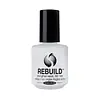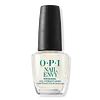What's inside
What's inside
 Concerns
Concerns

 Ingredients Side-by-side
Ingredients Side-by-side

Ethyl Acetate
PerfumingButyl Acetate
MaskingNitrocellulose
Adipic Acid
BufferingIsopropyl Alcohol
SolventPropyl Acetate
PerfumingTrimethyl Pentanyl Diisobutyrate
N-Butyl Alcohol
PerfumingTriphenyl Phosphate
Formaldehyde
Diacetone Alcohol
MaskingStearalkonium Hectorite
Gel FormingStearalkonium Bentonite
Gel FormingKeratin Amino Acids
Skin ConditioningDimethicone
EmollientCitric Acid
BufferingSodium Chloride
MaskingTitanium Dioxide
Cosmetic ColorantCI 60725
Cosmetic ColorantGum Base
Ethyl Acetate, Butyl Acetate, Nitrocellulose, Adipic Acid, Isopropyl Alcohol, Propyl Acetate, Trimethyl Pentanyl Diisobutyrate, N-Butyl Alcohol, Triphenyl Phosphate, Formaldehyde, Diacetone Alcohol, Stearalkonium Hectorite, Stearalkonium Bentonite, Keratin Amino Acids, Dimethicone, Citric Acid, Sodium Chloride, Titanium Dioxide, CI 60725, Gum Base
Ethyl Acetate
PerfumingButyl Acetate
MaskingNitrocellulose
Propyl Acetate
PerfumingTosylamide/Formaldehyde Resin
Isopropyl Alcohol
SolventTriphenyl Phosphate
Trimethyl Pentanyl Diisobutyrate
N-Butyl Alcohol
PerfumingFormaldehyde
Stearalkonium Bentonite
Gel FormingCamphor
MaskingDiacetone Alcohol
MaskingEthyl Tosylamide
Benzophenone-1
UV AbsorberCitric Acid
BufferingHydrolyzed Wheat Protein
Skin ConditioningDimethicone
EmollientCalcium Pantothenate
CI 60725
Cosmetic ColorantCI 77891
Cosmetic ColorantEthyl Acetate, Butyl Acetate, Nitrocellulose, Propyl Acetate, Tosylamide/Formaldehyde Resin, Isopropyl Alcohol, Triphenyl Phosphate, Trimethyl Pentanyl Diisobutyrate, N-Butyl Alcohol, Formaldehyde, Stearalkonium Bentonite, Camphor, Diacetone Alcohol, Ethyl Tosylamide, Benzophenone-1, Citric Acid, Hydrolyzed Wheat Protein, Dimethicone, Calcium Pantothenate, CI 60725, CI 77891
Ingredients Explained
These ingredients are found in both products.
Ingredients higher up in an ingredient list are typically present in a larger amount.
We don't have a description for Butyl Acetate yet.
This synthetic colorant is used to add a violet color to products. It is water-soluble.
Citric Acid is an alpha hydroxy acid (AHA) naturally found in citrus fruits like oranges, lemons, and limes.
Like other AHAs, citric acid can exfoliate skin by breaking down the bonds that hold dead skin cells together. This helps reveal smoother and brighter skin underneath.
However, this exfoliating effect only happens at high concentrations (20%) which can be hard to find in cosmetic products.
Due to this, citric acid is usually included in small amounts as a pH adjuster. This helps keep products slightly more acidic and compatible with skin's natural pH.
In skincare formulas, citric acid can:
While it can provide some skin benefits, research shows lactic acid and glycolic acid are generally more effective and less irritating exfoliants.
Most citric acid used in skincare today is made by fermenting sugars (usually from molasses). This synthetic version is identical to the natural citrus form but easier to stabilize and use in formulations.
Read more about some other popular AHA's here:
Learn more about Citric AcidWe don't have a description for Diacetone Alcohol yet.
Dimethicone is a type of synthetic silicone created from natural materials such as quartz.
What it does:
Dimethicone comes in different viscosities:
Depending on the viscosity, dimethicone has different properties.
Ingredients lists don't always show which type is used, so we recommend reaching out to the brand if you have questions about the viscosity.
This ingredient is unlikely to cause irritation because it does not get absorbed into skin. However, people with silicone allergies should be careful about using this ingredient.
Note: Dimethicone may contribute to pilling. This is because it is not oil or water soluble, so pilling may occur when layered with products. When mixed with heavy oils in a formula, the outcome is also quite greasy.
Learn more about DimethiconeEthyl Acetate is a fragrance.
Isopropyl Alcohol is more commonly known as rubbing alcohol. It is most commonly used as a solvent, meaning it helps other ingredients dissolve.
This ingredient is an astringent alcohol. Astringent alcohols may also irritate skin as they high amounts may strip away your skin's natural oils.
Other types of astringent alcohols include:
According to the National Rosacea Society based in the US, you should be mindful of products with these alcohols in the top half of ingredients.
Any type of sanitizing product will have high amounts of alcohol to help kill bacteria and viruses.
Learn more about Isopropyl AlcoholN-Butyl Alcohol is a fragrance.
We don't have a description for Nitrocellulose yet.
Propyl Acetate is a fragrance.
We don't have a description for Stearalkonium Bentonite yet.
We don't have a description for Trimethyl Pentanyl Diisobutyrate yet.
We don't have a description for Triphenyl Phosphate yet.
Formaldehyde is an organic compound (meaning it has a special type of carbon bond) most commonly used as a preservative with fungicide and germicide properties.
Our bodies naturally produce small and non-harmful amounts. It is also naturally occurring in foods such as pears, apples, fish, bananas, carrots, and bulb vegetables.
This ingredient is considered to be toxic and carcinogenic in high amounts by the US, Canada, Australia, and the EU.
According to the government of Australia, this ingredient is water-soluble, rapidly metabolized in the body, and only tiny amounts are absorbed through skin.
Some preservatives release formaldehyde as a side-product. These are required to be labeled "contains formaldehyde" in the EU.
According to the FDA, these are formaldehyde-related ingredients on labels:
Tiny amounts are allowed in products such as hand cream, bath products, nail treatments, lotions, mouth wash, hair products, eye makeup, vaginal deodorants, and shaving cream.
Formaldehyde is water-soluble.
Irritation or contact-dermatitis usually occurs in levels exceeding 0.1% of this ingredient.
Learn more about Formaldehyde